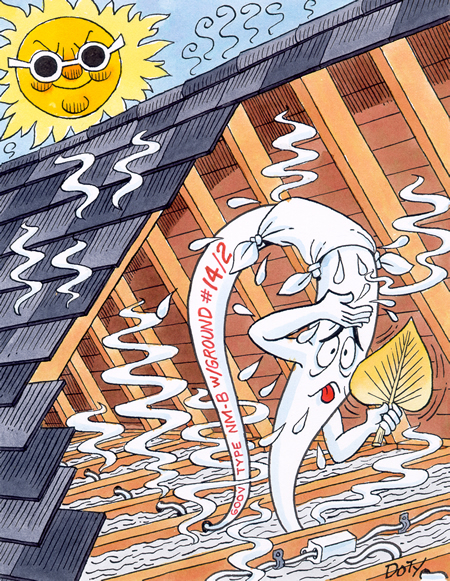October 2004
New Study Finds Attic Temperatures Can Pose Serious Risk
If you've ever been up in your attic on a sunny summer day, you know the meaning of hot. If you have a dark color roof on your house, the heat buildup in the attic can be unbearable. Well, pity your home's electrical wiring - it has to perform in this superheated environment day after day.
The heat doesn't affect the copper conductors in the wiring. They can handle far higher temperatures than those found in attics. The problem is the plastic insulation and jacketing that surround the wires. These are usually rated to withstand up to 194°F, but temperatures that approach this limit are not recommended.
Two factors combine to heat up the wire. The first is the heat in the surrounding, or ambient, air in the attic. Recent research carried out by the Copper Development Association has shown that ambient temperatures in attics can easily be 30° to 50°F higher than the outdoor temperature. Remember, the outdoor temperature that the weatherman quotes is measured in the shade.

As if that weren't enough, consider the second factor - the electrical current running through the wires heats them up even more. The CDA research has shown that temperatures of open wires in attics can get perilously close to the 194°F limit. If the wires are buried in attic insulation, pass over light fixtures or, worst of all, are arranged in tight bundles, they get even hotter than if they're out in the open air.
Wires so hot you can't touch them aren't good. One way to alleviate the heat is to use larger diameter wires - for example, use 12 gage instead of 14 gage, or 10 gage instead of 12 gage (larger wires have smaller gage numbers). Because larger wires offer less resistance to electrical current, they permit more current flow while staying cooler.
Another, perhaps more practical, solution is to add more circuits. That divides the electrical current among more wires instead of just a few overtaxed circuits. Additional circuits and circuit breakers also provide an increased safety margin. If you prefer this solution, you'll have to run some new lengths of wire, and it's always a good idea to use larger wires than those in place now.
Electrical usage per U.S. home has more than quadrupled since the 1950s. As a result, the wiring in many older houses, particularly those that have not been upgraded over the years, is insufficient and susceptible to dangerous overheating. Newer homes that have been wired to minimize cost can be susceptible to overloading, too.
If you have doubts about the safety of your home's wiring, call an electrician. A professional can quickly judge if you have a problem and tell you what it will cost to solve it, safely and efficiently. You can also visit the CDA's Building Wire section for more information about residential electrical wiring. ![]()
